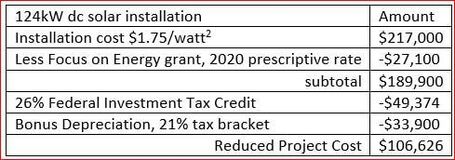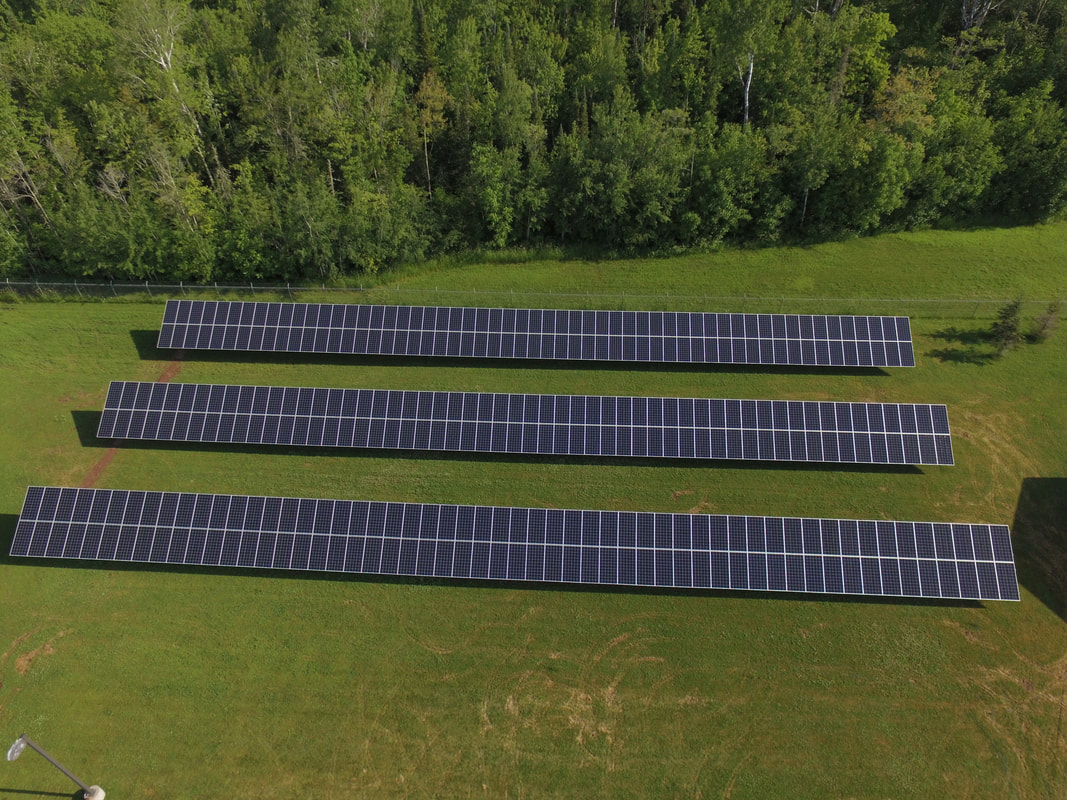|
Public Comment: March 29, 2021
Ref: SEP Docket 9705-FG-2020 Steffany Coker Public Service Commission One barrier to the Microgrid and Community Resilience Centers Pilot Grant Program might be the legislative restrictions in place regarding metering and subsequent interpretation of those rules by the utilities. Chapter PSC 113, SERVICE RULES FOR ELECTRICAL UTILITIES, Subchapter VIII — General Customer Metering and Meter Accuracy, paragraph PSC 113.0803 requires each tenant in a commercial building to have an individual meter. As an example of this potential barrier, in 2018 Bayfield County and the City of Washburn, co-owners of several Housing Authority buildings in that city, considered requesting a waiver to the Public Service Commission for master metering two of their buildings. Each apartment in the buildings has a separate meter. A master meter on each building would have saved hundreds of dollars per year in facility charges to the Housing Authority who pays all the utility bills, as well as readied the buildings for solar PV integration and battery storage for increased resilience. Xcel Energy reviewed PSC 113.0803 and all parties agreed that the legal language written therein prevented the master metering of the buildings. To make matters worse, two Housing Authority buildings, built prior to 1980, are master metered to which PSC 113.0803 doesn’t apply, but the buildings do not have a “solar window”. Xcel Energy has a current active docket before the PSC (4220-TE-106) Resiliency Service Pilot, but it is for large commercial customers who take service from a single meter. Our other local utility, Bayfield Electric Cooperative, does not allow behind-the-meter transfer of electricity across property lines. Under current regulations individual buildings with a single meter can successfully form a microgrid. An example is the Bad River Bad of Lake Superior Chippewa’s three recently installed microgrids. These buildings are “essential” tribal facilities as outlined in their 2018 Pre-disaster Mitigation Plan. This type of facility complies with current utility rules and might be the only focus allowed for the Microgrid and Community Resilience Centers Pilot Grant Program. Community centers, schools, and government buildings are good examples of potential candidates. To consider low-income housing as part of the Microgrid and Community Resilience Centers Pilot Grant Program, the PSC might review PSC 113.0803 and determine how it could be amended to allow master metering of apartment-style buildings or even a neighborhood or other groups of buildings. I believe the original intention of this rule in 1980 was to make tenants responsible for their electric consumption and thereby conserve energy (remember the Arab oil embargos of the 1970’s). With today’s technology, submetering individual apartments via wi-fi and data loggers could easily accomplish this goal and also allow for the goals of the resiliency program. An example of this type of submetering is laid out in Xcel’s EVR-1 tariff, where EV charging is submetered without the addition of a “meter”. Submitted by, Bill Bailey Cheq Bay Renewables [email protected]
1 Comment
 Third Party Participants (TPP) are legal entities, usually structured as limited liability corporations (LLC), who provide a means to monetize the Federal Investment Tax Credit (ITC) and provide a financing mechanism for site owners who want to install renewable energy on their premises. This arrangement provides upfront capital as well as reduced costs. I will try to explain why TTP are important to Wisconsin’s clean energy future. Commercial PV projects are economically feasible because of the decline in solar prices combined with Federal and State incentives. Installation costs are typically 60% below a decade ago. Wisconsin’s Focus on Energy RECIP program has reduced upfront costs by as much as 34% in 2019, but proposed changes in 2020 will eliminate the RECIP program for solar PV and be replaced by a Prescriptive Incentive which will reduce costs on a tiered schedule by, in general, about 12%. In addition, the Federal investment tax credit (ITC) plus bonus depreciation can reduce costs by another 41-50%[1]. This table represents a hypothetical example of a 2020 solar PV project owned by a business. 124kW dc (100kW ac) is used because it is Xcel Energy’s net metering limit. This installation would generate about 147,000kWh annually and the value of the electricity generated at a commercial General Service TOD rate is about $10,700 per year. This is a conservative estimate and does not include demand charge reduction which will vary by site, depending on energy usage patterns. Simple payback would be 10 years or if money is borrowed the value of the electricity generated would exceed the payments on a 20-year note at 4% interest by $1500 the first year, making it cash flow positive. This example is used to demonstrate how essential each component is to make a project financially viable. Municipalities, school districts and non-profits, however, cannot directly take advantage of the ITC and depreciation expense because they do not pay Federal income tax. Likewise, a business may not have the capital, or it may not be the best use of a business’ limited capital to invest in a solar project. To compensate, many states allow Third Party Participants (TPP), who own or co-own a solar installation for a minimum of 6 years, and use the tax credits, passing some of the savings on to a non-tax-paying entity. TTP can also provide upfront capital to any business or residence and could pass savings on to customers that might not have an adequate tax liability. TPP typically use the PV system as collateral to secure the financial arrangement, unlike banks who typically use real estate to collateralize a loan. TPP, therefore, have advantages in securing needed capital. Wisconsin is not one of those states allowing TPP and instead uses 1912 utility law as governance. The utility’s legal argument is that they are guaranteed a monopoly by law and the TPP is infringing on their territory and acting as a utility. The TPP’s argument is that they are not offering a service to the public, but rather are engaging with a single entity, and are providing a financing mechanism. The WI Public Service Commission has refused to take up this issue, deferring instead to the Wisconsin legislature. Without the ITC, coupled with the reduced rate of Focus on Energy funding, most municipal, school district and non-profit solar PV projects are no longer financially feasible in Wisconsin. Wisconsin’s legislators need to re-examine why they cannot move past 1912 utility law and find an equitable solution. Not all utilities are opposed to TPP. Bayfield Electric Cooperative and Dairyland Power Cooperative are supporting a TTP project in northern WI. Xcel Energy states that their hands are tied and it is ultimately not their decision. As of 2018, 26 States and the District of Columbia have adopted policies that include TPP.[3] Wisconsin is lagging behind in solar deployment because of an antiquated policy. TPP is a market-based solution providing necessary capital and savings for renewable energy projects. Upfront capital is needed for any project, whether it be a municipality, business or a residence. Using TPP leaves limited capital resources with the customer where they can do the most good. It seems clear, at least to me, that many investment-owned utilities are using the monopoly law as an excuse to rationalize not allowing TPP. In reality, they seem to be more concerned about the reduced income that customer-sited solar PV represents. This logic is based on fear, not statistics. Currently, customer-based solar penetration is a small fraction of energy generation and subsequently insignificant on a large utility's bottom line. Our local governments and schools are being disadvantaged because of this ill-conceived logic and our businesses and residences have restricted capital available to them. This will likely end up in the WI Supreme Court, but it shouldn’t be their decision either. The current law is limiting solar deployment in our schools, local governments and non-profits, as well as our businesses and residences, the grass-root entities that should be leading our clean energy future. It's time for the Wisconsin legislator to step up to the plate and pass clean energy policy that includes TPP. Bill Bailey Cheq Bay Renewables [1] ITC scheduled to be 26% in 2020 unless Congress extends tax credits. Bonus depreciation is based on income tax rates. [2] Price of recently installed municipal projects in Washburn, WI [3] Institute for Local Self Reliance: https://ilsr.org/states-agree-third-party-ownership-enables-distributed-solar-but-whats-next/ Recently, over 2.5mW of solar generating capacity has been added to the Cheq Bay area: Xcel's 1mW of community solar now almost complete, Bayfield Electric's 300kW of community solar installed in 2016, CBR's 552kW in last year's group buy and the ongoing group buy that is currently close to 300kWs and growing, and the various municipal projects like the Ashland County Courthouse (36kW), the Greater Bayfield Waste Water Treatment Plant (100kW) and others that will be started in the next month or so, like the Washburn WWTP, Bayfield County Jail and Washburn Elementary School, each at 100kW. So, with all this solar, where do we stand?
The Global Carbon Project compiles CO2 emissions data annually and the most recent numbers are quite frankly not good. Global CO2 emissions rose 1.6% in 2017 after being relatively flat the few years before. Was this an anomaly? Doesn't look like it as 2018's Global CO2 emissions were up 2.7% and predicted to increase again in 2019. Is this the fault of China and India? Not really, emissions rose 2.5% in the U.S. between 2017 and 2018. Here's another enlightening statistic: The carbon emissions in the last 25 years is about half of the total that humanity has ever produced. And this while we have known for about 75 years that global warming was taking place. Basically, we have made no significant progress in reducing our consumption or production of energy and taken the necessary steps to protect ourselves. Alarmist? You tell me. So, where do we stand? We have a long way to go, but at least locally we are trying. We need to keep up the momentum. Please support renewable energy in every way you can; your own home, your workplace, the way you vote. Together, we can make a difference! |
Author: Bill BaileyCheq Bay Renewables Archives
May 2021
Categories |


 RSS Feed
RSS Feed